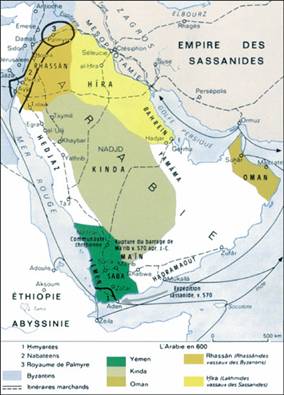Waves of Israelites to Arabia bringing Judaism in various stages of development
The traditional view of Arabian history centers on Yemen. It is assumed that a fairly developed civilization grew in the south of the Arabian Peninsula. For several hundred years it grew rich by exporting gold, frankincense and myrrh to the Roman Empire; as well as controlling the overland routes to India and the East. The first collapse of the Marib dam around 450 CE; the decline of the use of frankincense due to the Christianization of Rome; and the Rome success bypassing the desert by using a sea route led to the collapse of southern Arabian society. This in turn led to waves of immigration from the South to North, from the city to the desert.
Dr. Günter Lüling proposes an alternative paradigm.[1] He proposes a "more historical picture of Central Arabia, inundated throughout a millennium by heretical Israelites". He envisions waves of Israelite refugees headed, North to South, to Arabia bringing with them Judaism in various stages of development. Linguistic and literary-historical research in the Qur'an tends to support the notion of a more northerly origin for linguistic development of Arabic.[2] Here is a brief summary of three of these waves of Judaic immigration: Herodian, Sadducean and Zealot (explained in more detail elsewhere).[3]
During the time of Ptolemy, the native population of Cush originally inhabited both sides of the Red Sea: on the east, southern and eastern Arabia; and on the west, Abyssinia (Ethiopia-Eritrea). During the reign of Ptolemy VI Philometor (r 181–145 BCE), the Jewish High Priest Onias IV built a Jewish Temple in Heliopolis, Egypt and also one in Mecca, Arabia. He did this to fulfill his understanding of the prophecy of Isaiah 19:19, "In that day shall there be an altar to the Lord (Heliopolis) in the midst of the land of Egypt, and a pillar at the border (Mecca) thereof to the Lord." The border of Ptolemy's empire was in Arabia.The first wave of immigrants came with the success of the Maccabean, later Herodian, Judeo-Arab kingdom. Romanized Arabs (and Jews) from the trans-Jordan began migrating southward. The Tobiads which briefly had controlled Jerusalem, extended their power southward from Petra and established the "Tubba" dynasty of kings of Himyar. Yathrib was settled during this period.
The second wave of immigrants came before the destruction of the Temple, when refugees fleeing the war, as well as the Sadducean leadership, fled to Arabia. Khaibar was established as a city of Sadducean Cohen-Priests at this time.
The third wave of immigrants were mostly refugees and soldiers from Bar Kochba's revolt – fighters trained in the art of war and zealously nationalistic – sought refugee in Arabia.
This last wave of immigrants included people who are known in Islamic literature as the Aus and the Khazraj. Around 300 CE, they were forced out of Syria by the rising strength of Christian Rome, and the adoption of the Ghassan leader, Harith I, of Christianity. At first the Aus and Khazraj lived on the outskirts of Yathrib. According to Islamic sources, the Khazraj, headed by Malik ibn Ajlan, sought and obtained military assistance from the Bani Ghasaan; and having enticed the principal chiefs of Yathrib into an enclosed tent, massacred them.[4] Then the citizens of Yathrib, beguiled into security by a treacherous peace, attended a feast given by their unprincipled foes; and there a second butchery took place, in which they lost the whole of their leaders.[5]
References
- ↑ "A new Paradigm for the Rise of Islam and its Consequences for a New Paradigm of the History of Israel" by Dr. Günter Lüling; Originally appeared in The Journal of Higher Criticism Nr. 7/1, Spring 2000, pp. 23-53.
- ↑ Hagarism, Crone and Cook
- ↑ See the authors essays "The Prophet Muhammed as a descendant of Onias III" and "From Bar Kochba to the Prophet Muhammed"
- ↑ See Katib at Wackidi, p. 287.
- ↑ "Life of Mohamet I", by Sir Walter Muir, Chapter III, Section 6
